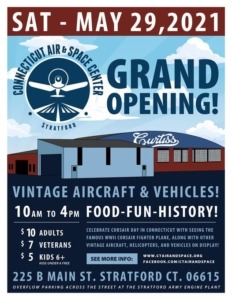Connecticut Air & Space Center Grand Opening: May 29th
The Connecticut Air & Space Center is a non-profit Air Museum that displays vintage aircraft, memorabilia, and artifacts that pertain to Connecticut, both inside and out. The museum’s motto is to: Honor, Preserve, Educate. Honoring the founders, workers, and companies from Connecticut. Preserving the vehicles and artifacts they used. And Educating this generation and the next about this history.
Founded by the late State Senator George Gunther in 1998 after the closing of the Stratford Army Engine Plant, in Stratford, the Connecticut Air & Space Center occupies buildings 6 and 53 at the former Stratford Army Engine Plant complex. The museum is one of only a handful throughout the country to be located in a portion of an original WWII aircraft factory. In 2012 the museum was damaged by Hurricane Sandy but has since recovered.
History:
The Army Engine Plant/Stratford (AEP/S) property is located at 550 South Main Street in Stratford, Connecticut. The 126-acre AEP/S property is occupied by a U.S. government-owned, contractor-operated manufacturing facility comprising numerous manufacturing buildings. The operator was Textron Lycoming, a Division of AVCO Corporation, a contractor to the U.S. Army Aviation Systems Command. The AEP/S property is bordered by industrial properties to the north; the Housatonic River to the east; a marsh which was a former landfill, to the south; and Igor I. Sikorsky Memorial Airport to the west.
Prior to 1927, the site was farmland. The property was developed in 1927 for Sikorsky Aircraft. In 1939, one of the world’s first successful commercial helicopters, the Sikorsky VS-300, was developed in Stratford by Igor Sikorsky and flown at his plant. The Chance Vought Aircraft company designed and constructed the Vought F4U Corsair as well as several other seaplanes and fighters until they moved in 1949. The Vought-Sikorsky Aircraft Division in Stratford built a total of 7,829 F4U fighters and these planes saw extensive combat in the Pacific Theatre of operations during World War II, and played a supporting role in the Korean War. The Lycoming company produced Wright radial engines at the site and after World War II, the plant was converted to produce turbines. The site was then owned by the Air Force through 1976. Ownership was transferred to the U.S. Army in 1976. Because of the Base Realignment and Closure actions of the United States Department of Defense, closure of the plant was recommended in July 1995. The plant closed in October 1998.
The Connecticut Air & Space Center currently occupies the research and design hangar where all experimental testing was performed by Chance Vought from 1944 to 1948. It’s the hope of the members of the CASC to remain at this location to later develop a world-class museum.

